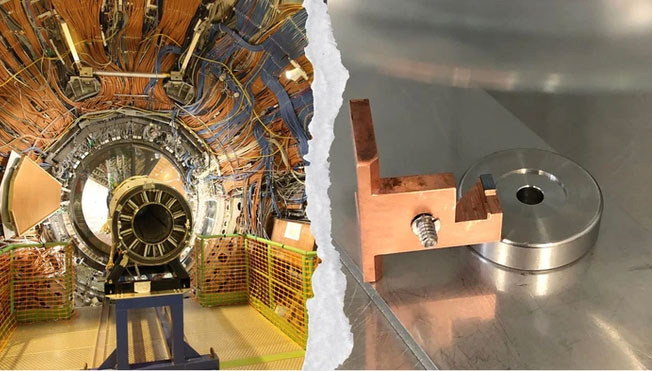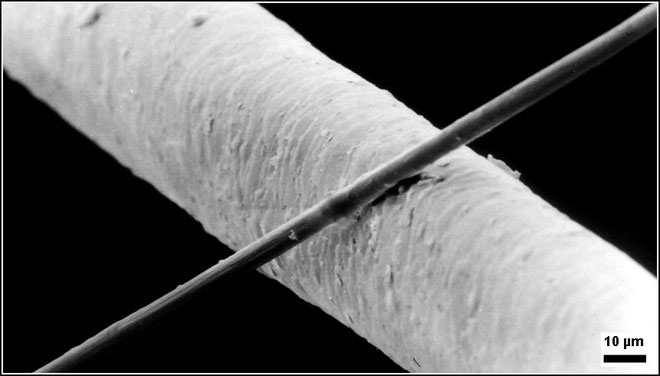Making a tiny particle accelerator: Only half the size of a hair, fits on a chip
'Just look at this chip design, no human flesh engineer can think of it'.
Large Hadron Collider (LHC) is a huge work located underground, with a circumference of up to 27 km, is the wonder of modern science and cost billions to build and operate. With the LHC, we delve into particle physics - that is, finding the inner structure and interaction of everything we know.

LCH on the left and DLA on the right.
And scientists have just done a work . opposite in size: they make a particle accelerator that is only 30 micrometers, a bit thicker than half a human hair.
This tiny structure is one of the latest achievements on the road to build 'accelerator-on-a-chip', a micro-particle accelerator that could make a breakthrough in science. study material, chemistry and medicine (in particular medicine manufacture). The small machine, called the Dielectric Laser Accelerator (DLA), will pave the way for cheaper, more compact accelerators that work at the energy level of a giant particle accelerator. giant at the present time. Possible applications include X-ray equipment, radiation equipment used in cancer treatment, industrial scanning equipment and more.
' The original idea was to reduce the size of the particle accelerator ,' 'Neil Sapra, lead author of the new study published in Science, said in a phone interview with Vice.

A 6 micron diameter carbon fiber is placed next to a 50 micrometre hairpiece.
Previous tests have shown that a light source can accelerate particles at a microscopic scale. The new device was developed on the basis of that theory and then improved on many points with a new design, capable of firing particles at a rate of 94% the speed of light.
' The important part of this research is that our device is the first example of a chip that contains a dielectric laser accelerator ,' said the researcher Sapra. ' This is the path to larger, more capable systems. '
The team of scientists was able to achieve this breakthrough with the 'photon reverse design' , that is, they achieved the design of an accelerator using a computer using an optimal algorithm, when observing the behavior of photons. at the nano scale.
The design of the accelerator used was a chip with a flat surface and many grooves for electron orientation. When fired at the surface of the infrared laser chip, the electron will accelerate and receive about 1 kiloelectrovolt of energy - 1 KeV.

An accelerator part is enlarged 25,000 times.
' Just by looking at this chip design, no flesh- and-mortar engineer can think of it ,' says Sapra. ' I don't think I can do it without the reverse photon technique because finding this design is too difficult, if I keep doing the old way .'
At the present time, the DLA design is still weak, the scale of the machine must be 1,000 times more than that for this accelerator to reach the megaelectrovolt mark - the activity level of particle accelerators. The team thinks it will take them about 5 to 10 years to create the first prototype of a small particle accelerator, which will reduce costs and increase the precision of many research disciplines, especially is medicine.
' These photon circuits are also based on the principles of the electronics industry, so this is not an attempt to make a smaller machine, this is an attempt to reduce the cost of the device ,' Sapra said.
- How will a large particle accelerator decipher the mystery of the universe?
- China will have the world's largest particle accelerator
- Brazil built a large particle accelerator with a football field
- China wants to build a particle accelerator twice as large as the LHC
- China built the world's largest particle accelerator
- The LHC accelerator will operate at the highest energy before
- China will have the world's largest particle accelerator
- The person with half face is not aging because of the particle accelerator input
- Visit the biggest machine in human history
- Can this Chinese super machine
- Large particle accelerator stops working due to mating bite
- Atom smasher creates new material
- Important discovery: The first decay observation of the Higgs particle
- The universe can disappear because of
 The US company is about to build a supersonic passenger plane of 6,000km / h
The US company is about to build a supersonic passenger plane of 6,000km / h Japan develops avatar robot as in fiction film
Japan develops avatar robot as in fiction film Australia tested the world's first mango picking robot
Australia tested the world's first mango picking robot America develops technology to separate water from animal waste
America develops technology to separate water from animal waste The LHC may soon decipher the formation of the universe
The LHC may soon decipher the formation of the universe  2011: LHC accelerator will stop operating for 1 year
2011: LHC accelerator will stop operating for 1 year  Re-launch the world's largest nuclear accelerator
Re-launch the world's largest nuclear accelerator  LHC accelerator sets a new record
LHC accelerator sets a new record  China built the world's largest particle accelerator
China built the world's largest particle accelerator  The powerful particle accelerator is equivalent to 10 million lightning strikes
The powerful particle accelerator is equivalent to 10 million lightning strikes 